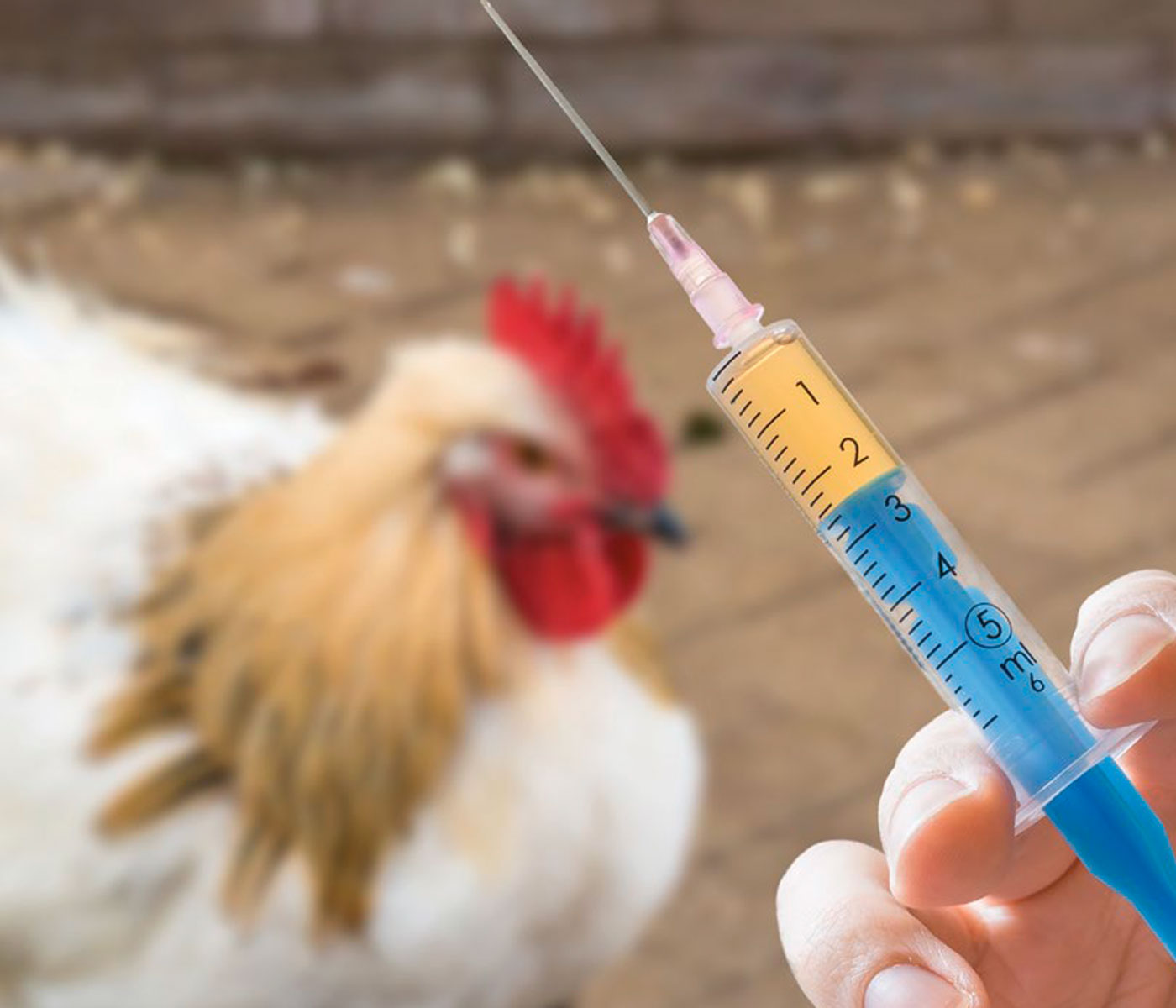Content available at: Indonesia (Indonesian) Melayu (Malay) ไทย (Thai) Tiếng Việt (Vietnamese) Philipino
Advancements in Poultry Salmonella Vaccine Strategies: Balancing Safety and Immunogenicity
Fowl typhoid and pullorum disease in birds are caused by the host-adapted Salmonella serovar Gallinarum (SG) biovar Gallinarum and Pullorum, respectively, resulting in high mortality rates and substantial productivity losses.
- Nevertheless, due to its limited host spectrum, Salmonella serovar Gallinarum does not represent a public health risk.
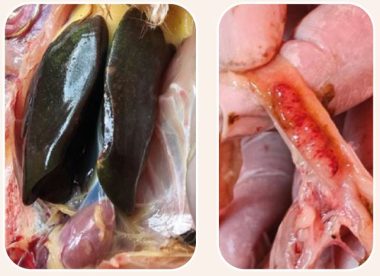
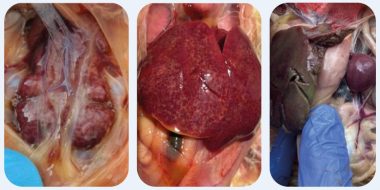
Instead, the non-adapted Salmonella, including serovars Enteritidis (SE) and Typhimurium (ST) are the most prevalent serovar-causing human salmonellosis outbreaks.
- Interestingly, approximately 25% of human salmonellosis cases are derived from poultry meat and egg consumption.
- Therefore, the global economic and public health risks that Salmonella possesses, as well as the need to reduce its prevalence in the poultry industry, are evident.
Worldwide efforts to control host-adapted and non-adapted Salmonella throughout the poultry production chain are intensifying.
- Many pre-harvest (prophylactic and therapeutic) and post-harvest intervention methodologies have been developed to reduce Salmonellas’ impact on the poultry industry and public health.
- Among the different on-farm prophylactic alternatives to control Salmonella in poultry (Table 1), vaccination can be highlighted as the chief strategy.
- However, research is still needed to improve the effectiveness of current commercial vaccines.
- The poultry industry and food safety organizations urge researchers to develop novel Salmonella vaccine formulations capable of enhancing the protective outcomes achieved by existing commercial vaccines and vaccination programs.
- To support this goal, it is essential to understand the strengths and limitations of currently available commercial vaccines.
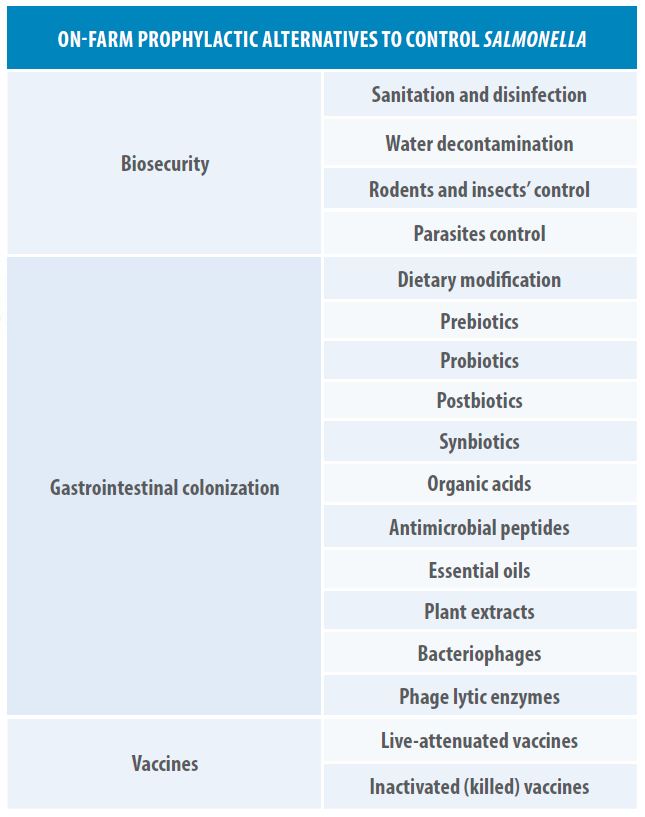
SALMONELLA VACCINES
Salmonella vaccine administration in poultry intends to decrease the Salmonella loads in the birds and environment, thereby preventing disease, interrupting the transmission cycle within and between flocks, supporting sustainable financial results in poultry production, and improving food safety.
- Since oral and respiratory mucosa are common infection routes for Salmonella, the next generation of Salmonella vaccines must offer effective protection specifically in mucosal surfaces.
- Moreover, the ideal Salmonella vaccine must protect against systemic infection, be irreversibly attenuated for humans and animals, have high efficiency in reducing fecal excretion and egg infection, be compatible with other Salmonella control measures, and provide a cost-effective bacterial control.
- For a vaccine to accomplish its purpose, it must effectively interact with the bird’s innate and adaptive immune system and trigger a robust, specific, multilayered, and long-lasting protective immune response without inducing adverse effects on the health or productive parameters of the flocks.
- For this aim, vaccines against Salmonella in poultry have been developed mostly using whole bacterial cells, either live-attenuated or inactivated (killed).
- Though, attempts have been made to produce subunit vaccines with results showing good mucosal, cellular and humoral immune responses, as well as protection against SE and ST challenges.
- Additionally, the innovative ghost vaccines have been demonstrated to be efficacious in generating humoral and cellular immune responses and eliminating systemic infection of SE and ST wild-type strains.
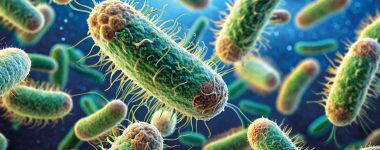
LIVE-ATTENUATED AND INACTIVATED (KILLED) SALMONELLA VACCINES
In the early 1800s, it was demonstrated that repeated bacterial passages could reduce their disease-causing potential through cumulative mutations, some of which decrease the expression of genes involved in bacterial virulence.
Following this discovery, various approaches have been employed to create live-attenuated Salmonella strains. By mutating genes in wild parental strains related to host survival, metabolism, and virulence factors, these strains have been constructed as candidates for live-attenuated vaccines.
On the other hand, the inactivated Salmonella vaccines’ initial work was done by Dr. Smith during the mid-50s. From that point onward, the inactivation process of microbial cells has been done using formaldehyde, glutaraldehyde, acetone, and other chemicals such as β-Propiolactone, as well as physical methods such as heat.
- Recently, technologies such as electron beam or gamma radiation have been studied for bacterial inactivation.
- These new technologies act quickly by damaging the double-strain and single-strain DNA within the bacterial cell.
- Thus, opposite to chemical inactivation, they protect the antigenic surface protein integrity during the inactivation process, allowing the initiation of an enhanced humoral and cellular immune response in vaccinated birds.
- For example, Ji and colleagues (2021) found that SG inactivated with gamma radiation initiated a higher humoral immune response than a live-attenuated SG 9r vaccine and a higher cell-mediated immune response than a formalin-inactivated vaccine.
Regarding live-attenuated bacterial vaccine strain construction, novel molecular biology techniques permit researchers to better understand the virulence factors involved in Salmonella infection at the gene level and to selectively inactivate, delete and transpose virulence genes.
Then, enabling the design and construction of site-specific and scarless genetically modified live-attenuated Salmonella strains suitable for vaccine development due to their antigenicity, immunogenicity and safety. In addition, Salmonella live-attenuated strain constructions can serve as a platform to express immunogenic protein epitopes for the design of heterologous recombinant sub-unit vaccines.
As previously mentioned, Salmonella vaccines, either live-attenuated or inactivated, should ensure correct activation of both innate and adaptive arms of the birds’ immune system to produce protective and long-lasting immunity.
- Live-attenuated Salmonella vaccines have been shown to effectively induce both cellular and humoral immune responses.
- Nonetheless, the characteristics and extent of these responses depend on considerations such as the constructed strain, administration route and the use of immunostimulants.
- Administering attenuated Salmonella strains through the oral route permits the pathogen-host interaction to happen in a natural path. It mimics a classic infection which has been noted as an advantageous feature of live attenuated vaccines.
- However, live-attenuated Salmonella vaccines can also be parenterally administered, showing good humoral and cell-mediated responses.
- Nevertheless, from a different perspective, live-attenuated Salmonella strains remain capable of reverting their virulence and pathogenicity, although researchers have been trying to ensure irreversible attenuation by different means with variable results.
- Due to the inherent risks of using attenuated Salmonella vaccines, the poultry industry has been using inactivated (killed) Salmonella vaccines, and researchers are working on developing newer inactivated vaccines as safer alternatives to attenuated-live vaccines.
Opposite to attenuated live vaccine strains, inactivated Salmonella vaccine strains lack the capacity to cause an infection that initiates a robust immune response.
Therefore, inactivated vaccines must be administered parenterally and in combination with an adjuvant proven to effectively initiate and sustain a sufficiently strong activation of the innate and adaptive immune systems.
As the role of adjuvants in inactivated vaccines is crucial to accomplishing the vaccination objective, it remains an active area of research.
- The immunological outcomes of using the parenteral route for vaccination with inactivated Salmonella vaccines are significantly different from those triggered by an orally administered live-attenuated vaccine capable of mimicking the Salmonella infection process.
- Although inactivated vaccines have been shown to trigger a potent humoral systemic immune response, it has been demonstrated that these do not strongly stimulate IgA production.
- Thus, these vaccines fail to protect the mucosal lumen and epitheliums from Salmonella colonization.
- Likewise, memory cell-mediated immune responses are not stimulated by inactivated Salmonella vaccine administration, which reduces their effectiveness.
- Then, although not yet commercially available, new adjuvants allowing inactivated Salmonella vaccines to be orally delivered are being developed.
- For example, chitosan nanoparticles used as an adjuvant for oral delivery of inactivated Salmonella vaccine in broilers have been proven to trigger protective antigen-specific humoral systemic and mucosal immune responses, thus reducing the Salmonella loads after challenge.
- In addition, an innovative technology is being tested to enhance the potential of parenteral-administered inactivated Salmonella vaccines to elicit humoral and cellular protective immune responses.
- In this regard, an experimental inactivated Salmonella vaccine design based on the use of agonistic-CD40 DNA aptamers efficiently stimulated the production and release of IgA into the gastrointestinal tract of broiler chickens, significant T- (CD4+ and CD8+) and B-cell responses after boost vaccination, and significantly reduced the cecal Salmonella loads in chickens following a challenge with SE (Uribe-Diaz et al., unpublished; Omolewu et al., unpublished).
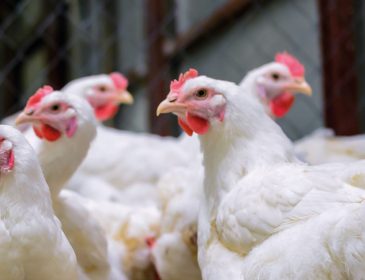
SUMMARY AND CONCLUSIONS
- Controlling host-adapted and non-adapted Salmonella serovars in poultry remains a critical public health and economic priority.
- Traditional vaccine approaches, such as live-attenuated and inactivated vaccines, have played a central role in mitigating these risks.
- Live-attenuated vaccines can induce strong, broad immunity by mimicking natural infection pathways but carry risks of reversion to virulence.
- On the contrary, inactivated vaccines, while safer, primarily elicit humoral responses and often lack the robust mucosal and cellular immunity needed to effectively control Salmonella colonization in the gut.
Recent advances in molecular biology and immunology are transforming vaccine development for Salmonella control. These technologies enable the design of genetically stable, attenuated Salmonella strains that are highly immunogenic and with a minimized risk of virulence reversion, presenting a promising approach for safer live-attenuated vaccine constructs.
Simultaneously, innovations in adjuvants and delivery systems—such as nanoparticles and agonistic-CD40 DNA aptamers— can enhance the efficacy of inactivated vaccines. These advancements can improve mucosal immunity and cellular responses, making inactivated vaccines more effective at preventing Salmonella colonization and shedding.
In developing more efficient vaccines and effective vaccination programs, understanding the immune responses triggered by Salmonella vaccines is crucial.
- Research into the vaccine’s mechanisms to stimulate both mucosal and systemic immunity is essential for optimizing protective effects.
- Combining live and inactivated vaccines, guided by this understanding, offers synergistic protection, exploiting the broad immune responses to live vaccines alongside the targeted, safe immunity of inactivated vaccines.
Together, these novel approaches bring the poultry industry closer to developing next-generation Salmonella vaccines and adapted vaccination programs that enhance safety and immunogenicity.
Continued research and optimization in this area may yield strategies that not only protect poultry health and productivity but also reduce the risk of Salmonella transmission to humans, supporting public health and food safety initiatives globally.
PDF
